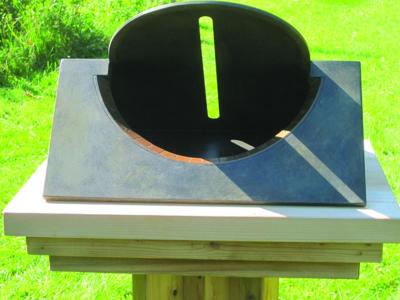There’s a lot of focus these days on solar energy, on harnessing the light from our nearest star to fuel our daily activities. Plants, of course, have been doing just that for millions of years. Sunlight, transformed by the green stuff in their leaves, is the energy that underlies almost all plant growth. Yet, though it is so fundamental to the garden, sunlight is very poorly understood by most gardeners. We distinguish only three kinds typically: full sun, part sun, and shade. We don’t bother often with the nuanced distinctions of morning versus afternoon sun, or the seasonal changes in the sunlight, let alone the changes, subtle but still quite distinct, that transpire from day to day.
Certainly, I had only the poorest understanding of sunlight until I met Robert Adzema and became fascinated by his sundials. Robert is a sculptor who originally became interested in the varying nature of sunlight and its natural cycles because of the impact they have on the appearance of outdoor art. Robert soon moved from speculation to the study of a branch of sculpture that had, over millennia, subjected sunlight to a rigorous analysis. That is, sundials.
He began to explore the history of sundials, back to the primitive use of shadows cast by natural objects that changed with the seasons and when they reached a specific point told farmers it was time to plant. He learned how sundials served as the first scientific instruments. They not only record very accurately the passage of the hours – into the early 20th century, there was a French railroad that set its engineers’ watches according to sundials, so up to the minute and reliable were these works of craft and art. Sundials also enabled their users to track the rising and setting of the stars and analyze the relation of our planet to the sun. Indeed, as Robert taught me, as long ago as the mid third century B.C., an ancients Greek scholar named Eratosthenes, used a sundial to measure the difference in the angle of the sun at noon at the two ends of Egypt and from that measurement he extrapolated very accurately the circumference of the earth.
With the encouragement of Robert’s sundials (he’s been making them now for more than 45 years), I’ve come to appreciate how the apparent motion of the sun across the vault of the sky changes with the seasons. I say “apparent” because of course it is we and the earth that actually move relative to the sun; the sun doesn’t cross the sky, it is just that the rotation of the earth makes it appear to do so. In the winter, the sun appears to ride low in the sky, rising through the spring to summer heights, and then sets again in the fall. Robert has created all sorts of dials that record this progress. One of my favorites is a memorial he created for seven families that had lost loved ones. He pierced that sundial with a hole through which passes a beam of light that at noon on each loved one’s birthday lights a different polished bead inscribed on the dial in the deceased’s memory.
Learning about the changes in the position of the sun relative to the earth has informed my gardening. Instructions for the placement of some light-sensitive plants, for example, recommend setting them where they will receive some early afternoon shade, shelter at the hottest part of the day. I know how to predict such a spot now, rather than merely rely on trial and error. And I know how to locate a spot for spring bulb plantings that will be penetrated by the sun early in the growing season when those plants need the solar fuel, even though it may be shaded later when the summer sun stands higher in the sky, and the bulbs are dormant.
The greatest benefit of a sundial in the garden, according to Robert, is the connection it creates between the viewer and the place. Reading a sundial unites the reader with the placement of the garden on the earth and with the season as well as the time of day and the heavens. Sundials, we agreed, take their time, in every sense of the phrase.
For more information about Robert and his sundials go to his website at Robertadzema.com, or listen to our conversation on the Berkshire Botanical Garden’s Growing Greener podcast at www.thomaschristophergardens.com/podcasts/sculpting-the-sun.-30-
Be-a-Better-Gardener is a community service of Berkshire Botanical Garden, located in Stockbridge, Mass. Its mission, to provide knowledge of gardening and the environment through a diverse range of classes and programs, informs and inspires thousands of students and visitors each year. Thomas Christopher is a volunteer at Berkshire Botanical Garden and is the author or co-author of more than a dozen books.









